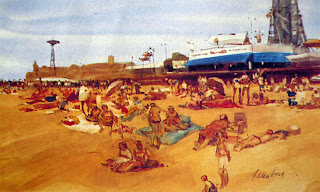In "Side Street in Rome" I approached the painting with a design that conveyed a sense of light and shadow. The sense of contrast is kept fairly subtle, the painting stays predominately in a middle value range. I massed in the large pattern first to establish the design and to remind myself to stay within a set value range for the lights and another for the areas of the image that were in shadow and indirect light.
I tend to mix on my palette with value in mind. The middle of my palette will have the puddles of color that are in the mid value range, the darks are mixed to the left and the lights to the right. The value puddles mimic the arrangement of colors on my palette. My palette is arranged from warm to cool from right to left and my white is on the right hand side, I'm right handed and the placement of white on the right makes sense to me. After years of working this way it has become second nature.
To get my point across when teaching students about value I compare light and shadow to Mafia families, the lights are the Colombos and the shadows are the Gambinos, if everybody stays where they belong in the picture nobody has to get rubbed out. So if you are painting an area in your image that is part of the shadow, not being lit directly, you load your brush from the middle and dark puddles on your palette.
I don't premix a range of values and colors, I can see it is a helpful method and it does help yield consistent results and the consistency is part of what I don't like about paintings of the premixed palette approach. There tend to be the same color and value choices regardless of the image being depicted and often times the darks never seem rich enough.
There is also a tendency to use the premixed color because the value corresponds to what is seen even if the color doesn't. There is a lot to be learned from various methods and systems and control is a great asset, until it controls an artist's willingness to take chances and respond to what a particular painting calls for. Method and system driven art tend to be safe choices offering few surprises along the way, there's a bit of a guaranteed look. There are key principles in approaching a painting or drawing, training and developing a reliable set of skills and working knowledge is crucial, just don't let the technical aspect of creating hamper your range of choices.
A work of art is the trace of a magnificent struggle. (Robert Henri)
Daily Paintings, Discussion Of Studio Work, News On Workshops, Classes, Events And Shows
Fine Art Search

Custom Search
Saturday, July 23, 2011
Wednesday, July 6, 2011
Shared Visions
 From my early teens I've been heading to Coney Island. Sometimes just to spend the day at the beach and other times to paint or sketch. As a young art student some of the Coney Island regulars would approach me as I was working to ask my if I knew the older guy who painted here alot. At the time I didn't know who it was.
From my early teens I've been heading to Coney Island. Sometimes just to spend the day at the beach and other times to paint or sketch. As a young art student some of the Coney Island regulars would approach me as I was working to ask my if I knew the older guy who painted here alot. At the time I didn't know who it was.  A number of years later I was at the Forum gallery to see an exhibition of David Levine's work, after seeing his beautiful watercolors of Coney Island I realized he was the artist that the Coney regulars were talking about. Seeing what he did with a subject that was near and dear to me was and still is inspiring. The watercolor at the bottom right, "Rock Fleas" is an example of Levine's work.
A number of years later I was at the Forum gallery to see an exhibition of David Levine's work, after seeing his beautiful watercolors of Coney Island I realized he was the artist that the Coney regulars were talking about. Seeing what he did with a subject that was near and dear to me was and still is inspiring. The watercolor at the bottom right, "Rock Fleas" is an example of Levine's work.The watercolor in the center is by Irwin Greenberg, a great artist and teacher. I was fortunate to have Greenberg as a teacher and to have him as my mentor as a teacher at the High School of Art and Design in New York City.
The top watercolor is one of my paintings.
 I structured the composition to form a z pattern. In the narrative I liked having this grouping of people clustered together but not interacting with one another, they are alone in their thoughts.
I structured the composition to form a z pattern. In the narrative I liked having this grouping of people clustered together but not interacting with one another, they are alone in their thoughts. I think it's important to find other artists who have a shared vision of a place. I never met David Levine but I know and love his work and it has been an influence on how I see one of my favorite subjects.
Some artists feel they have to shy away from the influence of other artists,
I couldn't disagree more, I think it can be an incredible resource.
Subscribe to:
Posts (Atom)
